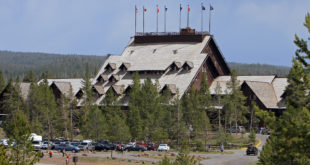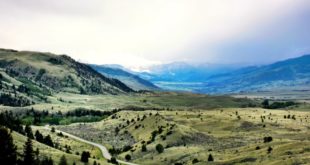The “Cascade Fire” is only six miles from the city of Red Lodge and threatening the popular ski resort just west of the city. One of the main highways leading to Yellowstone National Park, U.S. 212 (the Beartooth Highway), passes the edge of the fire area. It hasn’t been closed for general traffic, but it is being used to marshall equipment and personnel to the firefighting areas. An evacuation of Red Lodge (population about 3,530), is not expected.
Another fire that started near Fishing Bridge in Yellowstone Park jumped the Grand Loop Road at LeHardys Rapids on the Yellowstone River and forced a temporary closing of that segment of the highway (Fishing Bridge – Canyon). The main fire is now across the river, east of the road and poses no danger to people or buildings in the park. The Grand Loop Road has been reopened.
The plumes of forest fires in and around Yellowstone Park are a common sight from at least the end of July through mid-September. They begin as the very low humidity (10-20% during the day) dries out the underbrush and reduces the water content of the forest trees. In drought years, which has been the case for most of the last decade, the moisture in trees can be reduced to levels lower than ‘kiln-dried’ lumber (as low as 8%). Under such conditions, it doesn’t take much to start a forest fire – a stroke of lightning, a careless match or campfire.
Forest fires are a normal part of the ecology, a necessary piece of the life cycle for many trees, grasses, and other plants. Allowing chunks of the wilderness to burn freely has become routine policy for the park service and the U.S. Forest Service. More problematic, however, is the capacity of forest fires to roar out of the wilderness and into areas of human occupation. Like the Cascade fire, which began in or near a campground many miles down a lonesome road, it is the high, dry winds of summer – sometimes as strong as 40-50 mph – that can fan the flames into a wild ‘crown fire’, one that jumps from tree crown to tree crown with amazing speed. Such fires can travel miles in a day and overwhelm all efforts to contain them. This was the story of the great Yellowstone fires of 1988, and is the firefighters worst nightmare in places like Red Lodge.
The fire near LeHardy Rapids is the other kind, although it began with a downed power line west of the highway and made a spectacular crossing of road and river, it’s now off into the wilderness. After an initial emergency response that brought in fire fighting equipment and firefighters, the fire will now be allowed to burn itself out. That might not happen until the snow flies sometime between late August and mid-September. In the meantime the park service keeps an eye on the fires progress and condition, in this case from the watchtower on top of Mt. Washburn. The concern is for the prevailing winds, which usually flow west to east and carry these fires at this location deeper into the wilderness. However occasionally prevailing winds shift for a day or two and could drive the fires north or south into populated areas.
Another forest fire, 20 miles east of Yellowstone Park, called the “Gunbarrel Fire” has already burned 34 square miles mostly in the Shoshone National Forest and North Absaroka Wilderness area. In general, it’s moving away from settled areas. However, a portion of the fire continues to burn southward – down into the valley of the North Fork of the Shoshone River. Where it threatens lodges and cabins located along that stretch of the Buffalo Bill Highway (U.S. 20, 14, 16). Several campgrounds in the area have been closed.
In recent times, hardly a year goes by without road closures and health warnings due to heavy smoke. Fires that destroy property are much less common, but the Cascade fire has already claimed cabins and summer homes. These days, because of modern communications and fire management techniques, forest fires almost never take lives; but they remind us that the massed forces of nature are rarely benign from a human perspective.
 Yellowstone Insider Your Complete Guide to America's First National Park
Yellowstone Insider Your Complete Guide to America's First National Park





